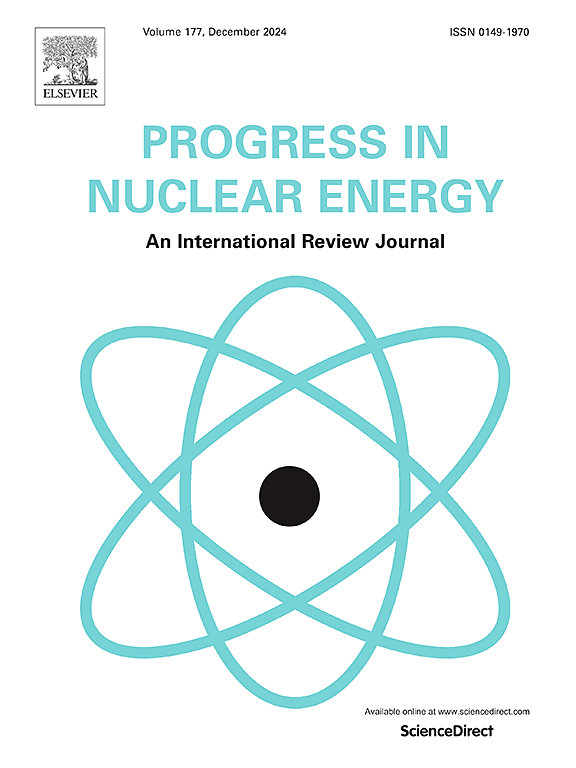介绍了核动力集装箱船屏蔽设计的辐射目标水平及其MCNP6代码的确定过程
IF 3.2
3区 工程技术
Q1 NUCLEAR SCIENCE & TECHNOLOGY
引用次数: 0
摘要
随着国际海事组织致力于到2050年海事部门的净零排放,核动力船舶因其零温室气体排放,长使用寿命和高能量密度而提供了一个可行的解决方案。然而,核动力推进的实施引发了对船员辐射暴露和国家安全的担忧,这些问题需要最佳的辐射屏蔽。本文提出了辐射目标水平(RTL)的概念,为核动力船舶的辐射屏蔽设计提供参考。为了在确保安全的同时最大限度地提高经济可行性,参考船(15,000 TEU集装箱船)被分为屏蔽区(包括反应堆和主屏蔽)和非屏蔽区(包括船员生活和工作区域)。根据ALARA原则,通过控制在该区域不同区域的停留时间(称为停留时间)来管理非屏蔽区的辐射暴露。使用MCNP6代码分析关键地点的辐射水平,并根据ICRP剂量限值评估允许停留时间。因此,本研究确定的最佳RTL为8.92 μSv/hr,确保船上所有人员符合1 mSv的年剂量限值。研究结果可为屏蔽设计、辐射区划分和船员暴露管理提供参考,有助于核动力船舶安全、经济可行地运行。本文章由计算机程序翻译,如有差异,请以英文原文为准。
Introducing radiation target level for the shielding design of a nuclear-powered container ship and its determination process using MCNP6 code
As the International Maritime Organization strives for net-zero emissions in the maritime sector by 2050, nuclear-powered ships offer a viable solution due to their zero greenhouse gas emissions, long operational lifespan, and high energy density. However, the implementation of nuclear propulsion raises concerns regarding crew radiation exposure and national security, issues that necessitate optimal radiation shielding. This study proposes the concept of radiation target level (RTL) to inform the radiation shielding design of nuclear-powered ships. To maximize economic viability while ensuring safety, the reference ship, a 15,000 TEU container ship, is divided into a shielding zone, which encloses the reactor and the primary shielding, and a non-shielding zone, which includes crew living and work areas. Radiation exposure in the non-shielding zone is managed by controlling the time spent in different areas of this zone, referred to as stay time, adhering to the ALARA principle. Using MCNP6 code, radiation levels are analyzed at key locations and permissible stay times are evaluated against ICRP dose limits. As a result, this study determined an optimal RTL of 8.92 μSv/hr, ensuring compliance with an annual dose limit of 1 mSv for all personnel on board. This result provides a reference for shielding design, radiation zone classification, and crew exposure management, contributing to the safe and economically viable operation of nuclear-powered ships.
求助全文
通过发布文献求助,成功后即可免费获取论文全文。
去求助
来源期刊

Progress in Nuclear Energy
工程技术-核科学技术
CiteScore
5.30
自引率
14.80%
发文量
331
审稿时长
3.5 months
期刊介绍:
Progress in Nuclear Energy is an international review journal covering all aspects of nuclear science and engineering. In keeping with the maturity of nuclear power, articles on safety, siting and environmental problems are encouraged, as are those associated with economics and fuel management. However, basic physics and engineering will remain an important aspect of the editorial policy. Articles published are either of a review nature or present new material in more depth. They are aimed at researchers and technically-oriented managers working in the nuclear energy field.
Please note the following:
1) PNE seeks high quality research papers which are medium to long in length. Short research papers should be submitted to the journal Annals in Nuclear Energy.
2) PNE reserves the right to reject papers which are based solely on routine application of computer codes used to produce reactor designs or explain existing reactor phenomena. Such papers, although worthy, are best left as laboratory reports whereas Progress in Nuclear Energy seeks papers of originality, which are archival in nature, in the fields of mathematical and experimental nuclear technology, including fission, fusion (blanket physics, radiation damage), safety, materials aspects, economics, etc.
3) Review papers, which may occasionally be invited, are particularly sought by the journal in these fields.
 求助内容:
求助内容: 应助结果提醒方式:
应助结果提醒方式:


